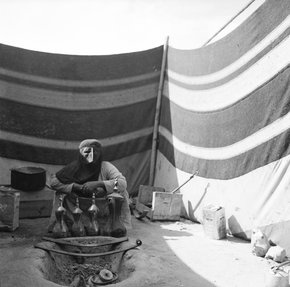The dallah is one of the most iconic symbols in the Arab tradition of hospitality. It is commonly made of aluminium or copper. The dallah has a distinctive shape, featuring a wide body that tapers in the middle with a long spout. The craft of making a dallah has become an art form in every part of the Arabian Gulf. The Raslan dallah, named after the Raslan family from the Levant is one of the most popular dallah types used in Qatar since the 19th century.
Traditionally, three dallahs were used in the process of making coffee. The first dallah, known as al-logmah, is used to boil the ground coffee in water. Once boiled, ground cardamom is added, and left to boil for a few more minutes. The coffee is then poured into the al-mazal dallah to serve the guests. To filter the cardamom shells, a small hemp rope made of palm leaves, called al-leef, is placed on the spout of the dallah to prevent the shells from falling into the cup. Coffee is served to guests from the al-mazal dallah. The last and largest dallah, known as al-khamrah, is used to store the extra coffee to be used later.
Nowadays coffee is commonly prepared using two dallahs. One to brew the coffee and the other to serve. It is customary for the al- muqahwi (coffee server) to hold the dallah in his left hand and coffee cups (finajil) in the right hand. Ready-mixed coffee can be bought from the souq (traditional market) with easy instructions to follow. The Qatari people often take the original coffee and customise it to their desired preference such as adding milk, saffron, and even mastic. The dallah has evolved over time and now comes in different shapes, sizes, designs, and colours.
